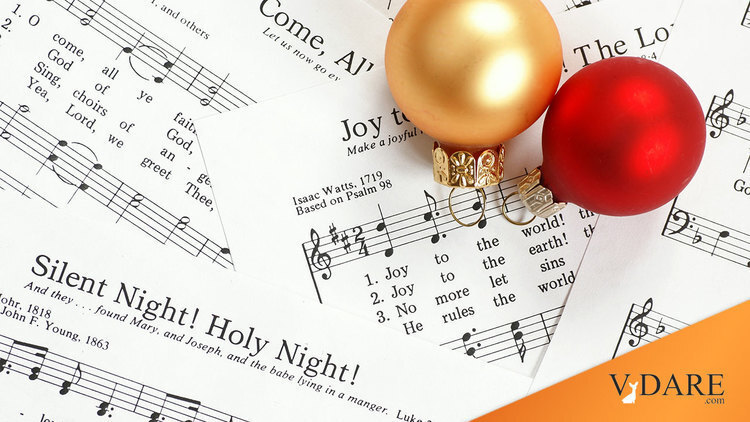January 05, 2010
WAR AGAINST CHRISTMAS COMPETITION 2009: [blog] [I] [2] [3] [4] [5] - See also: War Against Christmas 2008, 2007, 2006, 2005, 2004, 2003, 2002, 2001, 2000, 1999
Peter Brimelow writes: January 5 is Twelfth Night, the eve of Epiphany, traditionally the end of the Christmas season, the date after which in many English-speaking countries it's believed to be unlucky to leave your Christmas decorations up. Unlucky or not, I haven't yet finished writing up our annual War Against Christmas competition (but I'm trying!) However, it gives us a chance to post what I think is a seminal document in the Khristmaskampf: E.V. Kontorovich's July 1, 1997 New York Post column "The Gridlock To Come In Our Public Square", previously unavailable online. I'll be commenting on it further in my write-up VERY SOON NOW. Professor Kontorovich has escaped from journalism and now teaches law at Northwestern University
By E.V. Kontorovich
[First published in New York Post, July 1, 1997]
Come December, the traditional Christmas tree displays that usher in the holiday season at New York City public schools will be joined not just by the Jewish menorah, but by the Muslim star and crescent as well. To settle a federal lawsuit, the Board of Education agreed that any holiday symbol in the schools should be accompanied by symbols of festivals from other religions and cultures to "reflect different beliefs."
The board avoided a First Amendment landmine by presuming the star and crescent to be secular symbol, as the US Supreme Court declared Christmas trees to be in 1989. But the settlement still has a major problem: America's public square simply doesn't have the room to give equal space to all the faiths in the world.
The agreement also departs from the traditional American view of freedom of conscience – the idea that people of all faiths and creeds have a right to celebrate their holidays in their homes, school s and houses of worship. One sign of this: The man who spearheaded the lawsuit, M.T. Mehdi, is an unlikely proponent of such traditional notions of tolerance: A longtime PLO apologist, he once decried New York as a "Ziontown."
The implicit theory here is that religious equality gives each minority, no matter how small, a positive right to have its icons trotted out by Christians during their joyous – and harmless – observances. But the Muslims broke no new ground with their suit. They quite naturally sought the same privileges afforded the other religious minority, the Jews.
In 1906, thousands of Jewish students boycotted city schools, successfully demanding the abolition of mandatory Christian religious assemblies. Fair enough. But the demands did not stop with the end of majority coercion. Jews began to insist that the government elevate their religious symbols to the same public status as the Christian ones. Hence, the obligatory pairing of Christmas trees and menorahs, and, in many districts, an ecumenical vacation day on Rosh Hashanah and Yom Kippur.
In America, Christianity is different from other faiths in one salient respect. Christians are 84 percent of the population while the runners up, Judaism and Islam, make up just 2 percent each.
For better or worse, the nation was founded by Protestants and built by Christians, who indelibly marked American culture with the trappings of their faith. It is hubris to somehow think that one's tiny group is being shortchanged when the festivals receive less public recognition than those of the primary religion.
Call this demand for equal status the "Menorah Principle": In the name of fairness the two-percent religion now gets to pretend it's a dominant American religion, as ubiquitous as Christianity.
Once this principle triumphs, equity dictates that it must apply to all groups. The game plays out much like affirmative action, with its ever-growing list of preferred categories. Other groups, like the Muslims, inevitably piggy-back on the Jews' victories.
For example, in New Jersey's Cherry Hill, a school district far less diverse than New York, the Christmas holiday displays are crowded with Christmas trees, menorahs, Kwanzaa candle holders and gold-laminated pictures of Buddha.
The list is sure to grow. Groups that at first don't particularly care will eventually demand the same treatment as the others, if only to avoid being left behind when the rest are made "equal".
This doctrine of diversity actually contains a note of intolerance toward Christianity. Hanukah, which gets to share the state with Christian's biggest celebrations, is an insignificant festival from the perspective of Jewish piety. It only became fashionable as a reaction to Christmas. For some, imposing the imagery of small religions on the Christmas season is more about raining on the Christians' parade than celebrating one's own faith. After all, few leading practitioners of the Menorah Principle are devout practitioners of their own religions.
Given America's vast diversity, the Menorah Principle is untenable, even destructive. Take holidays for starters. If Christmas is an official national holiday, then why not the twelve days of Kwanzaa and the month-long Muslim festival of Ramadan? Even the calendar year is a scarce resource: If we honor all the special claims of the diverse U.S. populace, the many holidays would leave little time left for work or school.
Unless society draws a line—and the only obvious place to draw it is at Christianity—an unmanageable tumult will ensue: gridlock in the public square.













